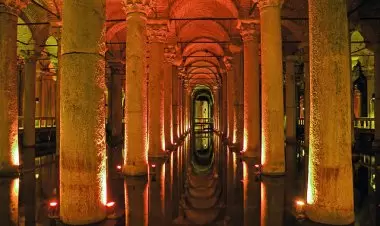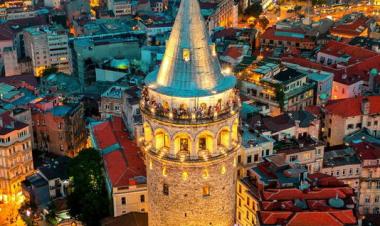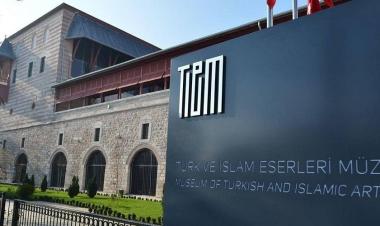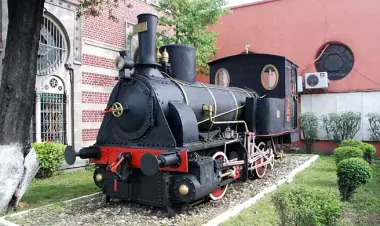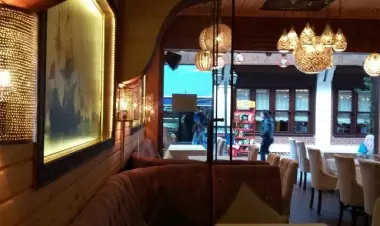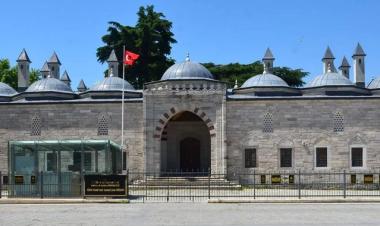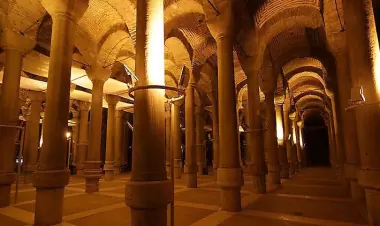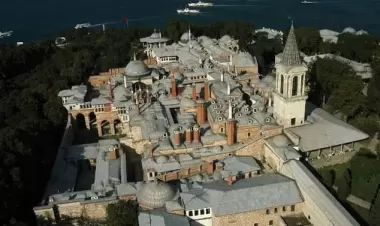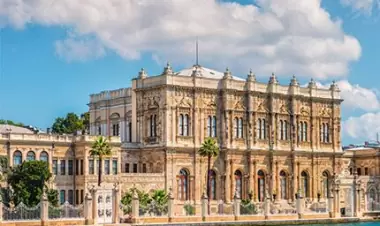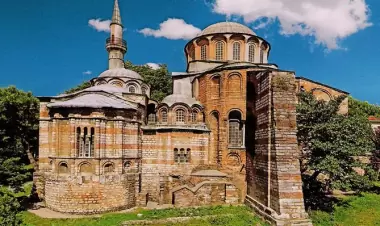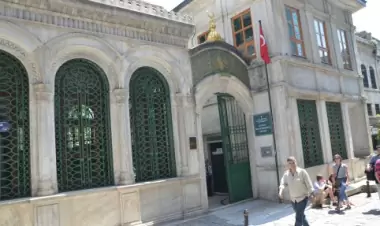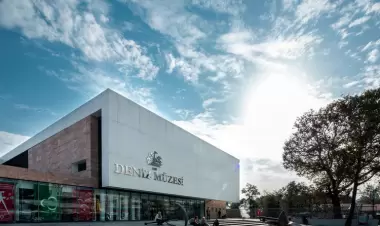Yildiz Palace

Yildiz Palace:A Symbol of Ottoman Legacy

The late 19th century during the reign of Sultan Abdulhamid II. The palace served as the Sultan's residence and administrative center from 1889 until 1909. The construction of Yildiz Palace began in 1880 and continued for nearly a decade. The palace was designed by a team of architects with inspiration from European Renaissance and Ottoman architecture, resulting in a unique blend of styles. The palace has over 30 buildings and pavilions spread across a lush green landscape, covering an area of over 500,000 square meters. Sultan Abdulhamid II moved to Yildiz Palace in 1889, making it his primary residence. It was a place where he could escape the political chaos of the city and enjoy his personal hobbies, including photography, smoking cigars, and gardening. The palace also served as a showcase of the Ottoman empire's wealth and power, as it was filled with extravagant artwork, furniture, and decorations. The palace played a key role in the political history of the Ottoman empire. Sultan Abdulhamid II used it as a base for his political and military actions, and it was the site of many important meetings with foreign dignitaries. In 1908, during the Young Turk Revolution, the palace was briefly occupied by the revolutionary forces, marking the beginning of the end of the Ottoman Empire. After the fall of the empire, the palace was used for a variety of purposes, including as a state guest house and as the headquarters of the Turkish parliament. Today, Yildiz Palace is open to the public as a museum, showcasing the lavish lifestyle of the Ottoman sultans and their families. It remains a popular tourist destination and an important historical landmark in Istanbul.
Yildiz Palace, located in the Beşiktaş district of Istanbul, is a magnificent Ottoman palace that once served as the residence of the Ottoman sultans. With its rich history, diverse architectural styles, and cultural importance, Yildiz Palace remains a significant landmark of Turkey’s imperial past. This article will explore the origins, architectural features, key historical events, and cultural role of the Yildiz Palace.
Origins and Construction

The Yildiz Palace was initially a modest villa called "Yildiz Villa" (meaning "Star Villa") in the late 19th century. Sultan Abdulhamid II, who ascended the throne in 1876, decided to expand this villa into a grand palace to serve as his primary residence and to consolidate his power. Construction began in the 1880s, and over several decades, various buildings and gardens were added to the complex, creating a vast and intricate layout.
Key Historical Events

The palace witnessed many significant events during the late Ottoman period. It was the center of political life during Sultan Abdulhamid II’s reign (1876–1909), including the Sultan’s isolationist policies, secretive governance, and his relationship with European powers. The palace also became a symbol of the sultan's struggle to maintain control over the empire, especially in the face of growing calls for modernization and political reform. The palace was also the site of Abdulhamid II’s eventual deposition in 1909, marking a major turning point in the empire’s history.
Architectural Style

Yildiz Palace is an eclectic blend of Ottoman, European, and Art Nouveau architectural styles. This fusion of different design traditions reflects the Ottoman Empire’s interactions with the European powers during the 19th century, as well as the vision of Sultan Abdulhamid II to create a palace that symbolized both traditional Ottoman grandeur and modernity.
Exterior Design and Layout
The palace complex consists of multiple buildings, gardens, and courtyards. The main building, known as the "Yildiz Sarayı," is characterized by a blend of neoclassical and Ottoman Baroque elements. The ornate facades, grand windows, and distinctive domes reflect both Western European and Ottoman influences. The surrounding gardens are meticulously landscaped, with water features, fountains, and carefully curated plants, showcasing a blend of European park design and Ottoman gardening traditions.
Interior Features
The interiors of Yildiz Palace are equally impressive, featuring a combination of traditional Ottoman design and Western European luxuries. The palace’s rooms are decorated with lavish furnishings, including ornate carpets, intricate woodwork, and gilded chandeliers. One of the most remarkable rooms is the Yıldız Pavilion, a charming, intimate space with intricate ceramic tiles and stained-glass windows. Many of the rooms also feature large mirrors, heavy curtains, and plush upholstery, contributing to the luxurious feel of the palace.
Notable Architectural Elements
The palace complex includes several notable architectural elements, such as:
- Yıldız Mosque: A mosque built within the palace grounds, blending Ottoman and neoclassical styles.
- Fountain and Pools: Ornate water features throughout the gardens, symbolizing the importance of water in Ottoman design.
- European Influence: A notable influence of Western European palaces, especially in the decorative features, furnishings, and grand halls.
Cultural Importance

Yildiz Palace holds great cultural significance in Turkey, both as a historical landmark and as a testament to the artistic achievements of the late Ottoman Empire. The palace not only represents the political power of the Ottoman sultans but also their patronage of the arts, architecture, and cultural exchange with the West.
Role in Ottoman Society
During its time as the royal residence, Yildiz Palace was the center of political power in the Ottoman Empire. Sultan Abdulhamid II used the palace as his main administrative hub, making decisions regarding the empire’s military, foreign policy, and internal governance. The palace was also a place for ceremonial events, where high-ranking officials, diplomats, and foreign dignitaries would visit to pay homage to the Sultan.
Patronage of the Arts
Sultan Abdulhamid II was a major patron of the arts, and Yildiz Palace reflects this through its interior design and artistic collections. The palace contains many examples of Ottoman and Western art, including paintings, sculptures, and intricate textiles. Abdulhamid II himself was an avid collector of European paintings and is known to have commissioned works from both Ottoman and European artists. The palace also served as a space for cultural events, including concerts, exhibitions, and gatherings of intellectuals.
Modern-Day Significance
Today, Yildiz Palace is a museum and a popular tourist destination. It offers visitors a chance to explore the rich history and culture of the late Ottoman Empire, as well as its complex relationship with Europe. The palace grounds also host cultural events and exhibitions, contributing to Istanbul's vibrant cultural scene.
FAQ:Frequently Asked Questions

When was Yildiz Palace built?
Construction of Yildiz Palace began in the 1880s and continued over several decades, with its transformation into the main residence of Sultan Abdulhamid II in the late 19th century. It was officially completed by the early 1900s.
What is the architectural style of Yildiz Palace?
Yildiz Palace is an eclectic blend of Ottoman, European, and Art Nouveau styles. Its design combines traditional Ottoman architectural elements with Western European influences, particularly seen in the palace’s interior decoration and furniture.
Who lived in Yildiz Palace?
Yildiz Palace was primarily the residence of Sultan Abdulhamid II, the 34th Sultan of the Ottoman Empire. It was his main residence and administrative center until his deposition in 1909.
Can tourists visit Yildiz Palace?
Yes, Yildiz Palace is open to the public and serves as a museum. Visitors can explore the palace's various buildings, gardens, and rooms, offering a glimpse into the life of the Ottoman sultans and the empire's history.
What is the significance of Yildiz Palace in Turkish culture?
Yildiz Palace is an important cultural and historical symbol of the Ottoman Empire’s late period. It showcases the empire’s transition towards modernization and its cultural exchange with European powers. The palace also remains an iconic site of the Sultan's reign, reflecting the artistic, political, and social life of the late Ottoman period.
When visiting Yıldız Palace in Istanbul, you can expect to see a variety of fascinating artifacts that reflect the opulence and cultural significance of the Ottoman Empire during the late 19th and early 20th centuries. These artifacts give insight into the lifestyle of the sultans, the architectural grandeur of the palace, and the cultural exchange between the Ottoman Empire and Europe. Here are some notable types of artifacts you can expect to encounter:
Furniture and Decorative Arts
- Ottoman-Style Furniture:Yıldız Palace contains a wide range of exquisite furniture pieces, many of which were used by Sultan Abdulhamid II and his family. These include elaborate chairs, tables, cabinets, and armchairs featuring intricate woodwork, gilded accents, and rich fabrics.
- Western European Influence:The palace's furniture shows strong European influences, including pieces from the Victorian and Art Nouveau periods, often crafted with high-quality materials like velvet, mahogany, and marble.
Ceramics and Tiles
- Ottoman Ceramics:The palace showcases fine examples of Iznik tiles and other ceramic works, which are known for their vibrant colors, floral motifs, and intricate patterns. Some rooms feature entire walls decorated with these colorful, hand-painted tiles, which were made using traditional techniques.
- European Ceramics:There are also examples of European porcelain and ceramic works that reflect the period's cultural exchanges with European art movements.
3. Paintings and Artworks
- European and Ottoman Paintings:Sultan Abdulhamid II was an avid collector of European paintings, and the palace displays works by famous Western artists of the time. In addition to European artworks, you will find Ottoman-style portraits and landscapes that celebrate the grandeur of the empire.
- Portraits of Sultans:There are numerous portraits of Sultan Abdulhamid II and other members of the royal family, capturing their likenesses in the formal, detailed style typical of the era.
Jewelry and Personal Items
- Sultan’s Personal Jewelry:Visitors can see a collection of jewels and accessories that belonged to the royal family, including gold and silver jewelry, brooches, and other items that reflect the luxury and wealth of the sultans.
- Clothing:Some rooms in the palace are furnished with historical garments, including royal robes, military uniforms, and traditional Ottoman attire, showcasing the fashion of the era.
Clock Collection
- European Clocks:One of the notable collections in Yıldız Palace is its collection of European clocks, some of which were gifts from foreign dignitaries. These clocks represent the period’s technological advances and are beautifully crafted, with ornate cases made from materials like bronze, wood, and porcelain.
Sultan Abdulhamid II’s Personal Items
- Sultan's Workroom Artifacts:The private chambers of Sultan Abdulhamid II offer a glimpse into his personal life. In his study, you can find writing instruments, books, and personal correspondence that give insight into his intellectual and political life.
- Photographs:There are old photographs documenting the life and reign of Abdulhamid II, some of which capture moments from his personal life, political activities, and royal functions.
Architectural Features and Decor
- Ornate Woodwork and Carvings:Many rooms in the palace feature exquisite wooden panels, carved moldings, and decorative wooden ceilings, showcasing the craftsmanship of Ottoman artisans.
- Chandeliers:The palace is decorated with chandeliers and light fixtures, many of which were designed in the European styles popular during the period. These fixtures are made of crystal, bronze, and brass, contributing to the opulent atmosphere.
Gifts and Diplomatic Artifacts
- Diplomatic Gifts:As the center of political life in the Ottoman Empire, Yıldız Palace also hosted many foreign dignitaries. Visitors can see gifts given to Sultan Abdulhamid II by foreign leaders, which include decorative objects, armor, and fine art that were part of diplomatic relations between the Ottoman Empire and European countries.
- Royal Ceremonial Items:Artifacts such as ceremonial swords, medals, and state gifts from various countries are also on display, reflecting the imperial nature of the Sultan’s rule and the empire’s interactions with other powers.
Photographs and Historical Documents
- The palace also features a collection of historic photographs and documents from the reign of Sultan Abdulhamid II. These include diplomatic correspondence, royal decrees, and personal letters, offering a glimpse into the political and social life of the late Ottoman Empire.
Gems and Precious Materials
- Precious Stones:The palace is home to various gemstones and decorative objects made from precious materials such as ivory, gold, and silver. These items were used both for personal adornment and for display during royal ceremonies.
10 Reasons to Visit Yıldız Palace

When visiting Yıldız Palace in Istanbul, you can expect to see a variety of fascinating artifacts that reflect the opulence and cultural significance of the Ottoman Empire during the late 19th and early 20th centuries. These artifacts give insight into the lifestyle of the sultans, the architectural grandeur of the palace, and the cultural exchange between the Ottoman Empire and Europe. Here are some notable types of artifacts you can expect to encounter:
Furniture and Decorative Arts
- Ottoman-Style Furniture:Yıldız Palace contains a wide range of exquisite furniture pieces, many of which were used by Sultan Abdulhamid II and his family. These include elaborate chairs, tables, cabinets, and armchairs featuring intricate woodwork, gilded accents, and rich fabrics.
- Western European Influence:The palace's furniture shows strong European influences, including pieces from the Victorian and Art Nouveau periods, often crafted with high-quality materials like velvet, mahogany, and marble.
Ceramics and Tiles
- Ottoman Ceramics:The palace showcases fine examples of Iznik tiles and other ceramic works, which are known for their vibrant colors, floral motifs, and intricate patterns. Some rooms feature entire walls decorated with these colorful, hand-painted tiles, which were made using traditional techniques.
- European Ceramics:There are also examples of European porcelain and ceramic works that reflect the period's cultural exchanges with European art movements.
Paintings and Artworks
- European and Ottoman Paintings:Sultan Abdulhamid II was an avid collector of European paintings, and the palace displays works by famous Western artists of the time. In addition to European artworks, you will find Ottoman-style portraits and landscapes that celebrate the grandeur of the empire.
- Portraits of Sultans:There are numerous portraits of Sultan Abdulhamid II and other members of the royal family, capturing their likenesses in the formal, detailed style typical of the era.
Jewelry and Personal Items
- Sultan’s Personal Jewelry:Visitors can see a collection of jewels and accessories that belonged to the royal family, including gold and silver jewelry, brooches, and other items that reflect the luxury and wealth of the sultans.
- Clothing:Some rooms in the palace are furnished with historical garments, including royal robes, military uniforms, and traditional Ottoman attire, showcasing the fashion of the era.
Clock Collection
- European Clocks:One of the notable collections in Yıldız Palace is its collection of European clocks, some of which were gifts from foreign dignitaries. These clocks represent the period’s technological advances and are beautifully crafted, with ornate cases made from materials like bronze, wood, and porcelain.
Sultan Abdulhamid II’s Personal Items
- Sultan's Workroom Artifacts:The private chambers of Sultan Abdulhamid II offer a glimpse into his personal life. In his study, you can find writing instruments, books, and personal correspondence that give insight into his intellectual and political life.
- Photographs:There are old photographs documenting the life and reign of Abdulhamid II, some of which capture moments from his personal life, political activities, and royal functions.
Architectural Features and Decor
- Ornate Woodwork and Carvings:Many rooms in the palace feature exquisite wooden panels, carved moldings, and decorative wooden ceilings, showcasing the craftsmanship of Ottoman artisans.
- Chandeliers:The palace is decorated with chandeliers and light fixtures, many of which were designed in the European styles popular during the period. These fixtures are made of crystal, bronze, and brass, contributing to the opulent atmosphere.
Gifts and Diplomatic Artifacts
- Diplomatic Gifts:As the center of political life in the Ottoman Empire, Yıldız Palace also hosted many foreign dignitaries. Visitors can see gifts given to Sultan Abdulhamid II by foreign leaders, which include decorative objects, armor, and fine art that were part of diplomatic relations between the Ottoman Empire and European countries.
- Royal Ceremonial Items:Artifacts such as ceremonial swords, medals, and state gifts from various countries are also on display, reflecting the imperial nature of the Sultan’s rule and the empire’s interactions with other powers.
9. Photographs and Historical Documents
- The palace also features a collection of historic photographs and documents from the reign of Sultan Abdulhamid II. These include diplomatic correspondence, royal decrees, and personal letters, offering a glimpse into the political and social life of the late Ottoman Empire.
10. Gems and Precious Materials
- Precious Stones:The palace is home to various gemstones and decorative objects made from precious materials such as ivory, gold, and silver. These items were used both for personal adornment and for display during royal ceremonies.
Here’s a FAQ (Frequently Asked Questions) section for visiting Yıldız Palace in Istanbul, highlighting 10 reasons why you should visit:
What is Yıldız Palace and why should I visit?
Yıldız Palace was the residence of Sultan Abdulhamid II, the last sultan to rule the Ottoman Empire, and is rich in Ottoman history and architecture. It offers a unique glimpse into the life of the Ottoman royal family and the opulence of the empire during the late 19th century.
What makes the architecture of Yıldız Palace special?
Yıldız Palace is an architectural gem that blends Ottoman styles with Western influences from the late 19th century. The building features a fascinating mix of neo-baroque, Art Nouveau, and traditional Ottoman design, making it a must-visit for architecture lovers.
Can I explore the gardens and outdoor areas of Yıldız Palace?
Yes! Yıldız Palace is surrounded by the lush Yıldız Park, a beautiful green space with walking paths, fountains, and spectacular views of the Bosporus. The gardens provide a peaceful escape from the busy city and are perfect for leisurely walks or a relaxing day in nature.
Is there a museum at Yıldız Palace?
Yes! The Yıldız Palace Museum showcases a collection of artifacts from the Ottoman Empire, including personal belongings of Sultan Abdulhamid II, historical documents, and paintings. The museum offers fascinating insights into the late Ottoman period and the life of the sultan.
What can I see inside the palace?
Inside Yıldız Palace, visitors can explore the private chambers of Sultan Abdulhamid II, including his study, bedroom, and living spaces. The rooms are furnished with exquisite Ottoman furniture, paintings, decorative arts, and personal items, giving a glimpse into the opulent lifestyle of the royal family.
Why is Yıldız Palace historically significant?
Yıldız Palace was not only a royal residence but also a center of political activity. During Sultan Abdulhamid II’s reign, important meetings and diplomatic events were held here, making it an important location for understanding the political dynamics of the late Ottoman Empire.
How is Yıldız Palace different from other palaces in Istanbul?
Unlike the more crowded Topkapi Palace or Dolmabahçe Palace, Yıldız Palace is a quieter, more intimate destination. Its off-the-beaten-path location means fewer tourists, offering a more relaxed and contemplative experience. It’s perfect for those seeking a peaceful visit with a focus on the history of the late Ottoman period.
Is there an art collection at Yıldız Palace?
Yes! Sultan Abdulhamid II was an art patron and collected European paintings as well as Ottoman-style artworks. The palace houses a collection of these paintings, allowing visitors to admire both Western art and traditional Ottoman art side by side.
Can I take a guided tour of Yıldız Palace?
Yes, guided tours are available and highly recommended for a deeper understanding of the history and significance of the palace. A guide can provide historical context, explain the artwork and artifacts, and give insight into Sultan Abdulhamid II’s life and reign.
What are the best times to visit Yıldız Palace?
The palace is open year-round, but the best times to visit are during the spring and autumn months when the weather is pleasant and the gardens are in full bloom. Weekdays are generally quieter than weekends, allowing for a more peaceful visit.
View On Map
Loc: 41.0507108, 29.0117042
Content Index
Others in Same Category
This site was created by a person who was born in Istanbul and is a lover of Istanbul, with the aim of introducing the beauties of the city to be discovered.
If you are planning to visit Istanbul or would like to get more information, you can contact with us via contact us button on below:
Contact Us


